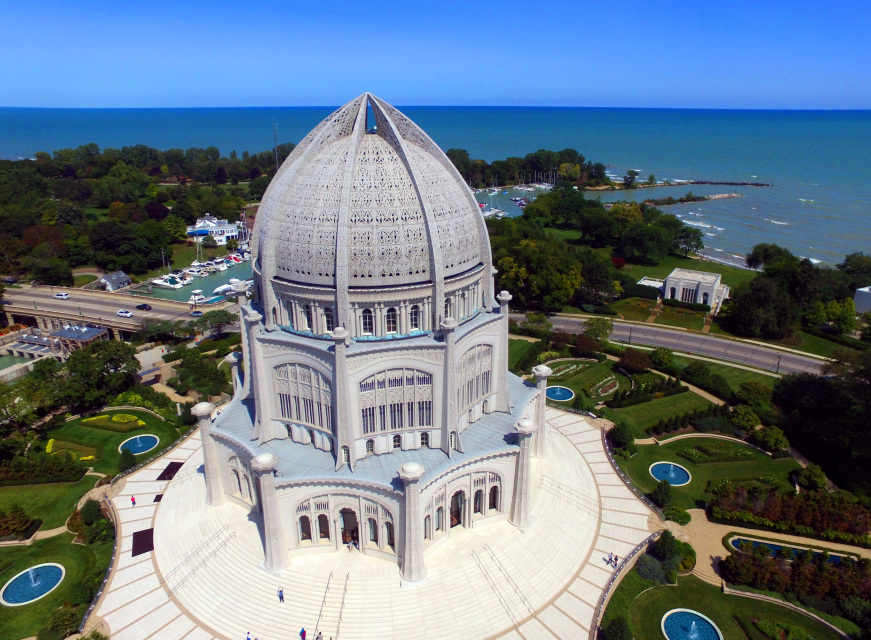The Baháí Faith Baha'is of the United States
Table Of Content

A site has been selected for a Bahá’í Temple in the vicinity of the Bahá’í World Centre on Mt. Carmel in Haifa, Israel. It is near the spot where Bahá’u’lláh chanted the Tablet of Carmel, the "Charter of the World Spiritual and Administrative Centers of the Faith on that mountain" according to Shoghi Effendi. A model based on the design was constructed and is on display in the upper hall of the mansion at Bahji. See a photograph from the Bahá'í World.In August 1971 the Universal House of Justice erected an obelisk on the site, on the side of which is the Greatest Name.
Origins ofthe Baha’i Faith
A burgeoning devotional spirit in a locality finds expression in prayer gatherings that foster social harmony, as well as in educational programs dedicated to building capacity for service to humanity. This interplay of worship and service becomes particularly apparent in communities where efforts to contribute to material and social progress are on the rise. While worship forms a key tenet of the House of Worship, service to humanity is considered an outward expression of the inner transformation that worship brings about.
Becoming a Baha’i: Nine journeys to faith
In 1920, delegates to the Bahá'í National Convention unanimously selected his innovative design. Bourgeois traveled to Haifa (in present-day Israel) to consult with ‘Abdu’l-Bahá, the son of the Founder of the Bahá’í Faith. With ‘Abdu’l-Bahá's encouragement, Bourgeois refined and scaled down the size of his design. Beyond all differences of race, culture, class or ethnicity, regardless of differences in customs, opinions, or temperaments, every individual is a member of one gloriously diverse human family. Each unique individual has a role to play in carrying forward an ever-advancing material and spiritual civilization. The building was financed entirely by voluntary contributions from Baha’is around the world.

Divine Justice: The Poor Will Have His Comfortable Cottage
DRC House of Worship: Peaceful environs inspire thoughtful discussion on the environment BWNS - Baha'i World News Service
DRC House of Worship: Peaceful environs inspire thoughtful discussion on the environment BWNS.
Posted: Thu, 17 Aug 2023 07:00:00 GMT [source]
As of 2023[update], fourteen Baháʼí Houses of Worship have been completed around the world (including one that was later destroyed). Eight of the thirteen that are currently standing are continental Houses of Worship, located in the United States, Uganda, Australia, Germany, Panama, Samoa, India, and Chile. Two of the continental Houses of Worship, the Lotus Temple and the Santiago Baháʼí Temple, have won numerous architectural awards. Baha’is celebrate a spiritual “Feast” every nineteen days, observe the Baha’i Holy Days, get together for study circles and parties and elections and open meetings called firesides for seekers, and hold social and spiritual gatherings for a wide variety of other purposes. While Feasts have devotional, consultative and social portions, what those look like depends entirely on who hosts the event. At some Holy Days, Baha’is can say special prayers that have been revealed, but no actual ritual goes with the saying of the prayer.
Gilmer is also a known local leader of Racial Justice, and sees this event, just in time for both Juneteenth and Father’s Day, as a continuation of our unifying work to build One Human Family. Gilmer, a long-time resident of Wilmette, is inspired by the teachings of the Baha’i Faith, which is centered on the Oneness of Humanity. These delegates represent communities whose activities begin with a “simple strand of love.” They are drawn from diverse backgrounds and perspectives and symbolize the vibrant threads, tethering each district to the whole. Through consultative processes and reflective dialogue, they weave together the patterns of patient and concentrated local efforts into an emerging national tapestry of Bahá’í community life.
Uniting Prayer and Action: The Baha’i House of Worship
During your visit, you are free to explore the Baha’i Faith’s unifying teachings, including the oneness of humanity, the common threads among all major religions, and the connection between the human spirit and the betterment of the world. Baháʼí Houses of Worship are open to both Baháʼís and non-Baháʼís for prayer and reflection. All Baháʼí Houses of Worship have a round, nine-sided shape and are surrounded by nine pathways leading outwards and nine gardens. Baháʼí literature envisages Houses of Worship surrounded by a number of dependencies dedicated to social, humanitarian, educational, and scientific pursuits, although no Baháʼí House of Worship has yet been built up to that extent. At present, most Baháʼí devotional meetings occur in individuals' homes or local Baháʼí centres rather than in Baháʼí Houses of Worship. Consultations will explore how the Bahá’ís and their friends can intensify efforts to contribute to humanity’s movement toward peace and social progress.
Continental Houses of Worship
All nine temples share certain design features, including domes and gardens. Each temple is nine-sided because Bahá’ís consider the number nine—the highest single number—a symbol of oneness, comprehensiveness and unity. In Wilmette, the temple includes nine entrances and nine verses above the doors and the alcoves. It has been named a National Historic Landmark, one of the Seven Wonders of Illinois and is visited by 250,000 people a year. Aside from being called the “Temple of Light and Unity,” the 1100-seat Wilmette building is known as the “Mother Temple of the West” by Bahá’ís around the world. The establishment of Houses of Worship is intertwined with the development of Bahá’í communities worldwide.
Architect
Slightly more than 40 meters tall, its surface shining white marble, the temple at times seems to float above its 26 acre (105,000 m²) nine surrounding ponds. Bahá’í communities own many properties where Houses of Worship remain to be constructed as the Bahá’í community grows and develops further. One local House of Worship and two national Houses of Worship are currently under construction. More than 140 singers from many races, faiths, and backgrounds are coming from the United States, Canada, and Europe to sing in the 15th annual Baha’i Choir Festival under the direction of Van Gilmer, an internationally known performer and composer.
It is a collective centre of society to promote cordial affection where everyone is held in its embrace as equals. This edifice is dedicated to the one God, the Creator of all humanity and of the entire universe. BAHÁ’Í WORLD CENTRE — This podcast episode from the Bahá’í World News Service explores how worship and service to humanity—two foundational aspects of living a spiritual life—mutually reinforce one another, paving the way to building more peaceful and harmonious communities. This is one of the seven Bahá'í Temples in the world, and the only one in North America.
The property is set high in a natural bushland setting of 380,000 square metres in Ingleside, a northern suburb overlooking the Pacific Ocean. Baháʼí Houses of Worship are intended to include several social, humanitarian, and educational institutions clustered around the temple, although none have been built to such an extent. The temples are not intended as a local meeting place, but are instead open to the public and used as a devotional space for people of any faith. Is a place for prayer, meditation, and exploration about the connection between worshiping God and offering service to humanity. All are welcome to enjoy the beauty of the gardens and the unique design of the building; to gather on its grounds for fellowship, prayer and reflection. The very design of a Baha'i House of Worship, inviting everyone equally within its embrace, symbolizes the oneness of humankind.
In this manner, a House of Worship is envisioned to become a centre for social, scientific, educational and humanitarian services, living up to its title of the “dawning-place of the mention of God”. Suburban Chicago isn’t the first place that comes to mind when you think of major religious centers. But Wilmette, a small town located less than 10 miles north of the Windy City, is home to the only Bahá’í House of Worship in North America.
Continental Houses of Worship in Kampala, Uganda, and Sydney, Australia, were both inaugurated in 1961. The "Mother Temple of Latin America" in Panama City, opened eight years later, and the "Mother Temple of the Pacific Islands" was completed in Apia, Samoa in 1984. These elegant buildings appear to blend naturally into their surrounding landscapes, encircled by beautiful gardens of rare and native plants, which enhance the beauty of the sites and their atmosphere of spirituality.
The following list is an overview of Baháʼí Houses of Worship (Mashriqu'l-Adhkár) throughout the world that have been constructed, are currently under construction, or are in the planning phases. Whether you are exploring the Bahá'í Faith or looking to become an active member, there are various ways you can connect with our community.
Key initiatives include educational programs fostering community building and active engagement in societal discourse and social action. In localities where these efforts are flourishing, a greater appreciation for unity is fostered. People from all backgrounds find a shared sense of purpose as they explore the deeper meaning of life.
I love the feeling of making that spiritual connection as the sun rises in the east to illuminate the earth. I guess the combination of my own inner awakening as I pray, coupled with the quiet dawning of the new day’s light, seems somehow deeply soul-satisfying. By the early 1900s, nearly one thousand people in the United States and Canada had embraced the Bahá’í Faith.
Comments
Post a Comment